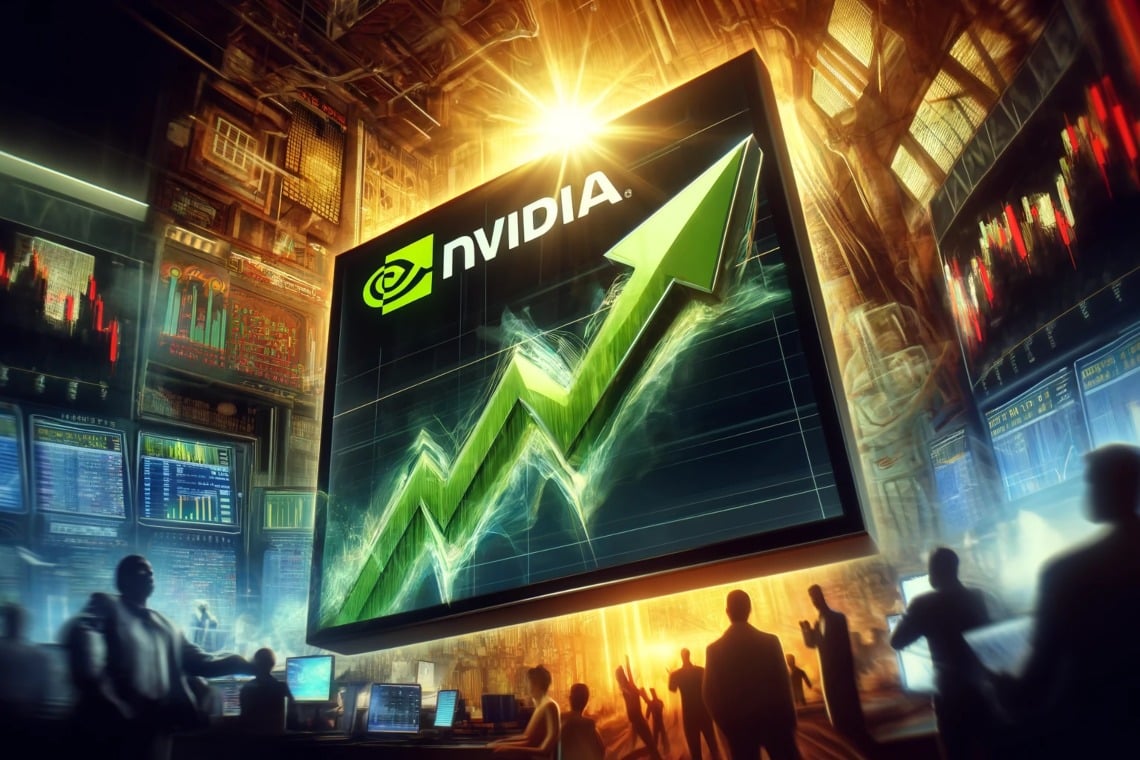Why has Nvidia’s Stock Price Soared Recently?
The Remarkable Surge of Nvidia’s Stock: Uncovering the Catalysts Behind Its Meteoric Rise
Nvidia’s Stock Price

Nvidia Corporation, renowned for its powerful graphics processing units (GPUs) and cutting-edge artificial intelligence (AI) technology, has seen its stock price soar recently. This dramatic rise in Nvidia’s stock price has captured the attention of investors, analysts, and technology enthusiasts alike. Several factors have contributed to this surge, ranging from technological advancements and strategic business decisions to favorable market conditions and robust financial performance. This comprehensive article delves into the myriad reasons behind Nvidia’s recent stock price escalation, providing an in-depth analysis of the company’s growth trajectory.
Introduction
Nvidia, established in 1993, has consistently been at the forefront of innovation in the semiconductor industry. Over the past few years, the company’s stock has experienced significant appreciation, driven by its dominant position in various high-growth markets. This article will explore the factors propelling Nvidia’s stock price to new heights, including technological advancements, strategic acquisitions, market dynamics, and financial performance.
Nvidia’s Technological Advancements
Leading in AI and Machine Learning
One of the primary reasons for Nvidia’s recent stock price surge is its leadership in AI and machine learning. Nvidia’s GPUs are the gold standard for AI and machine learning applications, providing unmatched performance and efficiency. The company’s CUDA platform, which enables developers to leverage the power of GPUs for general-purpose computing, has become a cornerstone in the AI community.
Nvidia’s continuous innovation in GPU technology, such as the introduction of the Ampere architecture, has significantly enhanced the performance of AI applications. The A100 Tensor Core GPU, based on the Ampere architecture, has set new benchmarks for AI performance, driving widespread adoption across industries. This technological leadership has solidified Nvidia’s position as a critical enabler of the AI revolution, contributing to the soaring stock price.
Expansion into Data Centers
Nvidia’s expansion into data centers has been another significant growth driver. The company’s GPUs are increasingly used in data centers for AI training and inference, high-performance computing, and data analytics. Nvidia’s acquisition of Mellanox Technologies in 2020 further bolstered its data center offerings by providing high-performance networking solutions.
The demand for data center GPUs has surged due to the exponential growth of data and the increasing complexity of AI models. Nvidia’s data center business has become a significant revenue driver, with major tech companies like Google, Amazon, and Microsoft adopting Nvidia’s GPUs for their cloud services. This expansion into data centers has played a crucial role in the recent surge in Nvidia’s stock price.
Dominance in Gaming
Gaming remains a core revenue stream for Nvidia, and the company continues to dominate this market with its GeForce GPUs. The launch of the GeForce RTX 30 series, based on the Ampere architecture, introduced significant performance improvements and real-time ray tracing capabilities. These advancements have been well-received by gamers, driving strong demand for Nvidia’s gaming GPUs.
The gaming industry has experienced robust growth, driven by trends such as the rise of eSports, the popularity of streaming platforms, and the increased adoption of virtual reality. Nvidia’s ability to consistently deliver cutting-edge gaming technology has reinforced its market leadership and contributed to the recent stock price surge.
Foray into Autonomous Vehicles
Nvidia’s investments in autonomous vehicles represent another key growth area. The Nvidia Drive platform, which provides hardware and software solutions for autonomous driving, has gained traction with major automotive manufacturers and startups. Nvidia’s vision of AI-driven autonomous vehicles positions it as a crucial player in the future of transportation.
The autonomous vehicle market is expected to grow significantly in the coming years, driven by advancements in AI and sensor technology. Nvidia’s early investments and strategic partnerships in this space have positioned it well to capitalize on this growth, further boosting its stock price.
Strategic Acquisitions and Partnerships
Acquisition of Mellanox Technologies
Nvidia’s strategic acquisition of Mellanox Technologies in 2020 for $6.9 billion was a significant move to strengthen its data center offerings. Mellanox’s high-performance networking solutions complemented Nvidia’s GPUs, providing a more comprehensive suite of products for data centers. This acquisition has enhanced Nvidia’s competitive position in the data center market, contributing to its recent stock price surge.
ARM Holdings Acquisition
In September 2020, Nvidia announced its intention to acquire ARM Holdings, a leading semiconductor and software design company, for $40 billion. This acquisition, if approved, would be transformative for Nvidia, providing access to ARM’s extensive ecosystem of processors and intellectual property. ARM’s technology is ubiquitous in mobile devices, and the acquisition would enable Nvidia to expand its reach into new markets, including mobile computing, IoT, and edge computing.
The ARM acquisition has been viewed positively by investors, as it has the potential to significantly expand Nvidia’s addressable market and drive future growth. However, the acquisition is subject to regulatory approval, and its successful completion will be a key factor in Nvidia’s future stock performance.
Strategic Partnerships
Nvidia has also formed strategic partnerships to drive innovation and expand its market presence. Collaborations with major tech companies, research institutions, and industry leaders have enabled Nvidia to stay at the forefront of technological advancements. These partnerships have been instrumental in driving adoption of Nvidia’s technology across various industries, contributing to the recent stock price surge.
Financial Performance
Robust Revenue and Earnings Growth
Nvidia’s strong financial performance has been a major factor in the recent stock price appreciation. The company has consistently delivered robust revenue and earnings growth, driven by strong demand for its GPUs across gaming, data centers, and AI applications. In its fiscal year 2023, Nvidia reported record revenue of $26.91 billion, a 61% increase year-over-year.
Nvidia’s strong revenue growth has been accompanied by impressive earnings growth. The company’s net income for fiscal year 2023 was $9.75 billion, a 125% increase compared to the previous year. This robust financial performance has been a key driver of investor confidence and the recent surge in Nvidia’s stock price.
Diversified Revenue Streams
Nvidia’s diversified revenue streams have also contributed to its financial strength. While gaming remains a core revenue stream, the company has successfully expanded into new markets such as data centers, AI, and autonomous vehicles. This diversification has reduced Nvidia’s reliance on any single market and provided multiple growth drivers.
The data center segment has become a significant revenue contributor, accounting for 40% of Nvidia’s total revenue in fiscal year 2023. The growth of this segment has been driven by strong demand for AI and high-performance computing applications. Nvidia’s ability to diversify its revenue streams has been a key factor in its strong financial performance and recent stock price appreciation.
Strong Balance Sheet
Nvidia’s strong balance sheet has provided the financial flexibility to invest in growth opportunities and navigate market uncertainties. As of the end of fiscal year 2023, Nvidia had $21.1 billion in cash and cash equivalents, providing a solid financial foundation for future investments and acquisitions.
The company’s strong financial position has also enabled it to return value to shareholders through dividends and share repurchases. In fiscal year 2023, Nvidia returned $2.8 billion to shareholders through dividends and share repurchases, reflecting its commitment to delivering shareholder value.
Market Dynamics
Growing Demand for AI and Machine Learning
The growing demand for AI and machine learning applications has been a significant market dynamic driving Nvidia’s stock price. AI and machine learning are transforming industries such as healthcare, finance, and manufacturing, creating strong demand for high-performance computing solutions. Nvidia’s GPUs, with their superior performance and efficiency, are well-suited for these applications, driving strong demand for its products.
The AI market is expected to continue growing at a rapid pace, driven by advancements in technology and increasing adoption across industries. Nvidia’s leadership in AI positions it well to capitalize on this growth, contributing to the recent surge in its stock price.
Expansion of Data Centers
The expansion of data centers has also been a key market dynamic driving Nvidia’s stock price. The growth of cloud computing, big data, and AI has created strong demand for data center infrastructure. Nvidia’s GPUs are increasingly used in data centers for AI training and inference, high-performance computing, and data analytics.
The data center market is expected to continue growing, driven by the increasing volume of data and the need for more powerful computing solutions. Nvidia’s strong presence in the data center market positions it well to benefit from this growth, contributing to the recent stock price surge.
Gaming Industry Growth
The gaming industry has experienced robust growth, driven by trends such as the rise of eSports, the popularity of streaming platforms, and the increased adoption of virtual reality. Nvidia’s GeForce GPUs are the preferred choice for gamers, providing superior performance and graphics capabilities.
The continued growth of the gaming industry is expected to drive strong demand for Nvidia’s gaming GPUs. The launch of new gaming consoles and the increasing popularity of gaming laptops are also expected to contribute to this growth. Nvidia’s dominance in the gaming market has been a key factor in the recent stock price appreciation.
Emergence of Autonomous Vehicles
The emergence of autonomous vehicles represents a significant growth opportunity for Nvidia. The company’s Nvidia Drive platform provides hardware and software solutions for autonomous driving, positioning it as a key player in this emerging market. The autonomous vehicle market is expected to grow significantly in the coming years, driven by advancements in AI and sensor technology.
Nvidia’s early investments and strategic partnerships in the autonomous vehicle market have positioned it well to capitalize on this growth. The company’s technology is being adopted by major automotive manufacturers and startups, driving strong demand for Nvidia’s solutions. This growth opportunity has been a key factor in the recent surge in Nvidia’s stock price.
Investor Sentiment
Positive Analyst Coverage
Positive analyst coverage has been a key driver of Nvidia’s recent stock price surge. Many analysts have highlighted Nvidia’s strong market position, technological leadership, and growth opportunities in AI, data centers, and autonomous vehicles. Upbeat analyst reports and price target increases have boosted investor confidence, contributing to the recent stock price appreciation.
Institutional Investor Interest
Institutional investor interest has also played a role in Nvidia’s stock price surge. Many large institutional investors have increased their holdings in Nvidia, reflecting their confidence in the company’s growth prospects. The involvement of high-profile investors has further boosted investor sentiment and contributed to the recent stock price appreciation.
Retail Investor Enthusiasm
Retail investor enthusiasm has also been a contributing factor to Nvidia’s recent stock price surge. Platforms like Reddit’s WallStreetBets have highlighted Nvidia as a top stock pick, driving increased interest and trading activity among retail investors. The rise of retail investing and the influence of social media have amplified the impact of positive sentiment on Nvidia’s stock price.
Challenges and Risks
Competitive Pressures
Despite its strong market position, Nvidia faces intense competition from companies such as AMD, Intel, and other emerging players in the semiconductor industry. Competitive pressures could impact Nvidia’s market share and pricing power, affecting its financial performance.
Regulatory and Geopolitical Risks
Nvidia operates in a highly regulated industry and is exposed to geopolitical risks. Trade tensions, tariffs, and regulatory changes could impact Nvidia’s business operations and financial performance. The pending acquisition of ARM Holdings is also subject to regulatory approval, and any delays or challenges could impact Nvidia’s future growth prospects.
Market Cyclicality
The semiconductor industry is known for its cyclicality, with periods of strong demand followed by downturns. Economic downturns or shifts in market dynamics could impact Nvidia’s revenue and earnings growth. The company needs to navigate these cycles effectively to sustain its growth trajectory.
Technological Disruptions
Rapid technological advancements and disruptions could pose risks to Nvidia’s business. New technologies or innovations could impact demand for Nvidia’s products or create new competitive threats. Nvidia’s ability to stay at the forefront of technological innovation will be critical to its future success.
Conclusion
Nvidia’s stock price has soared recently due to a combination of technological advancements, strategic acquisitions, robust financial performance, and favorable market dynamics. The company’s leadership in AI and machine learning, expansion into data centers, dominance in gaming, and foray into autonomous vehicles have been key growth drivers. Strategic acquisitions such as Mellanox Technologies and the pending acquisition of ARM Holdings have further bolstered Nvidia’s growth prospects.
Nvidia’s strong financial performance, driven by robust revenue and earnings growth, has been a key factor in the recent stock price appreciation. The company’s diversified revenue streams, strong balance sheet, and commitment to innovation have positioned it well to capitalize on future growth opportunities.
Positive analyst coverage, institutional investor interest, and retail investor enthusiasm have further boosted investor sentiment, contributing to the recent stock price surge. However, Nvidia faces several challenges and risks, including competitive pressures, regulatory and geopolitical risks, market cyclicality, and technological disruptions.
Overall, Nvidia’s recent stock price surge reflects the company’s strong market position, technological leadership, and growth potential. As Nvidia continues to innovate and expand its market presence, it is well-positioned to sustain its growth trajectory and deliver value to shareholders. The company’s journey provides valuable insights into the dynamics of the technology industry and the factors that drive long-term stock performance.




